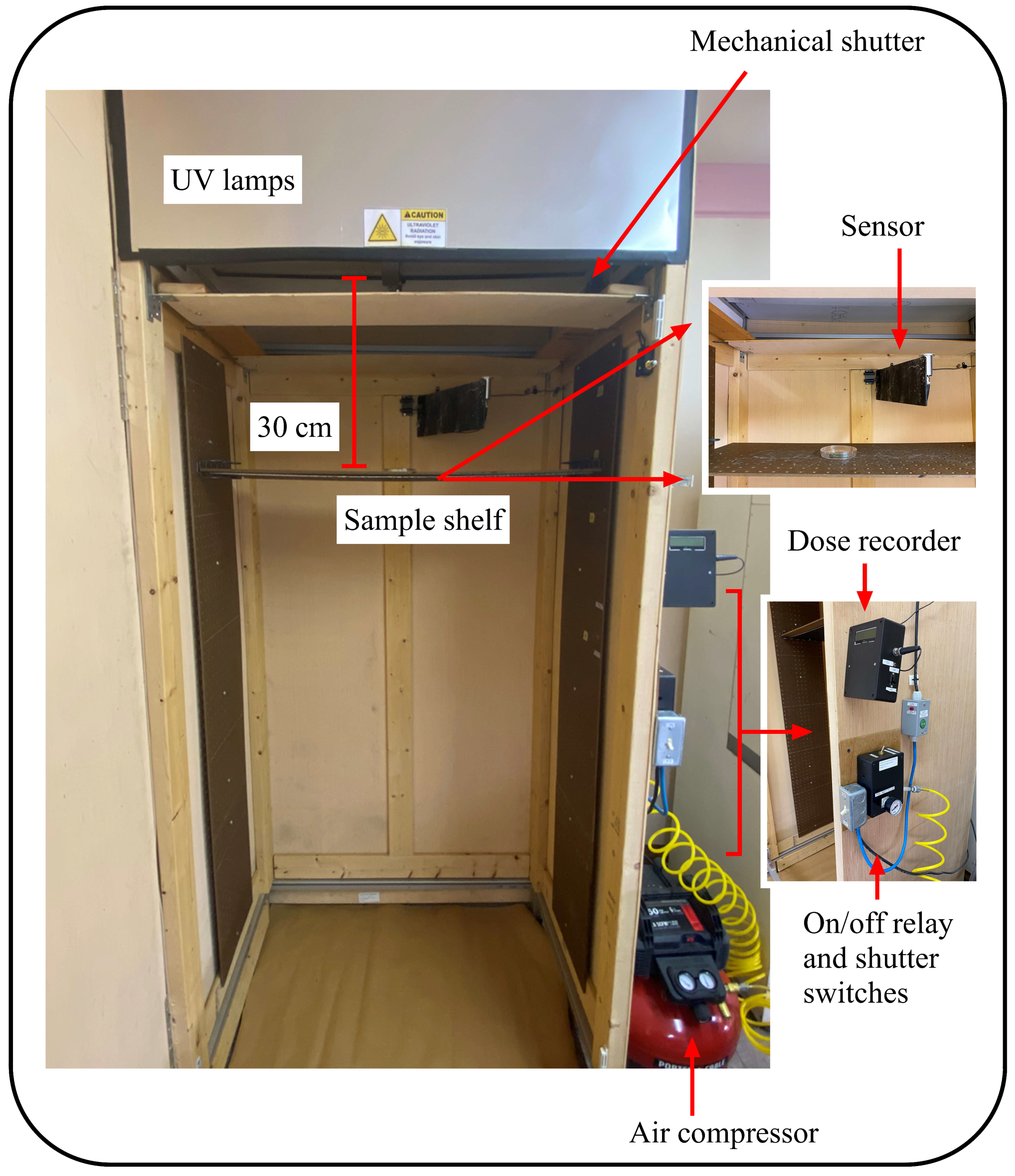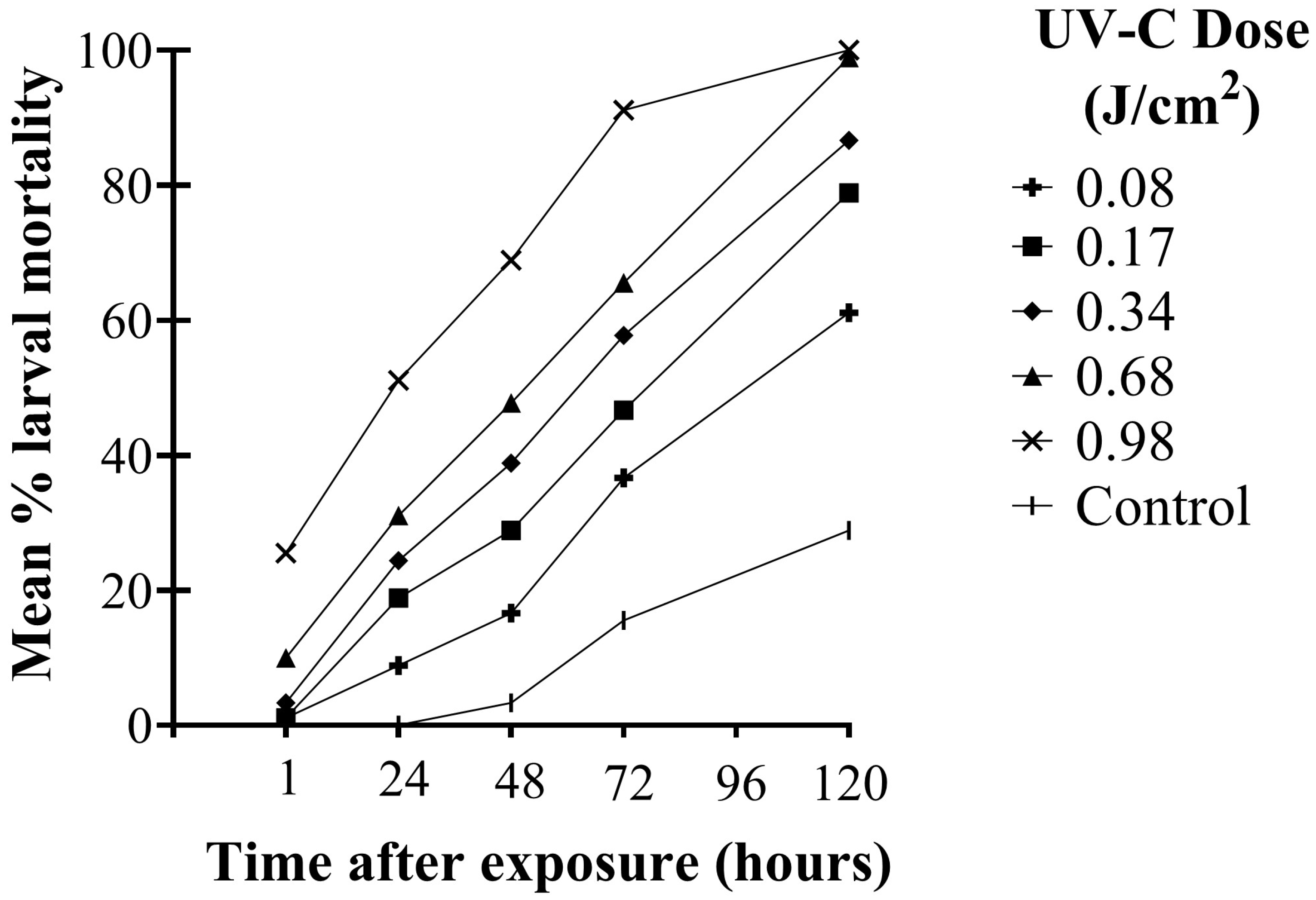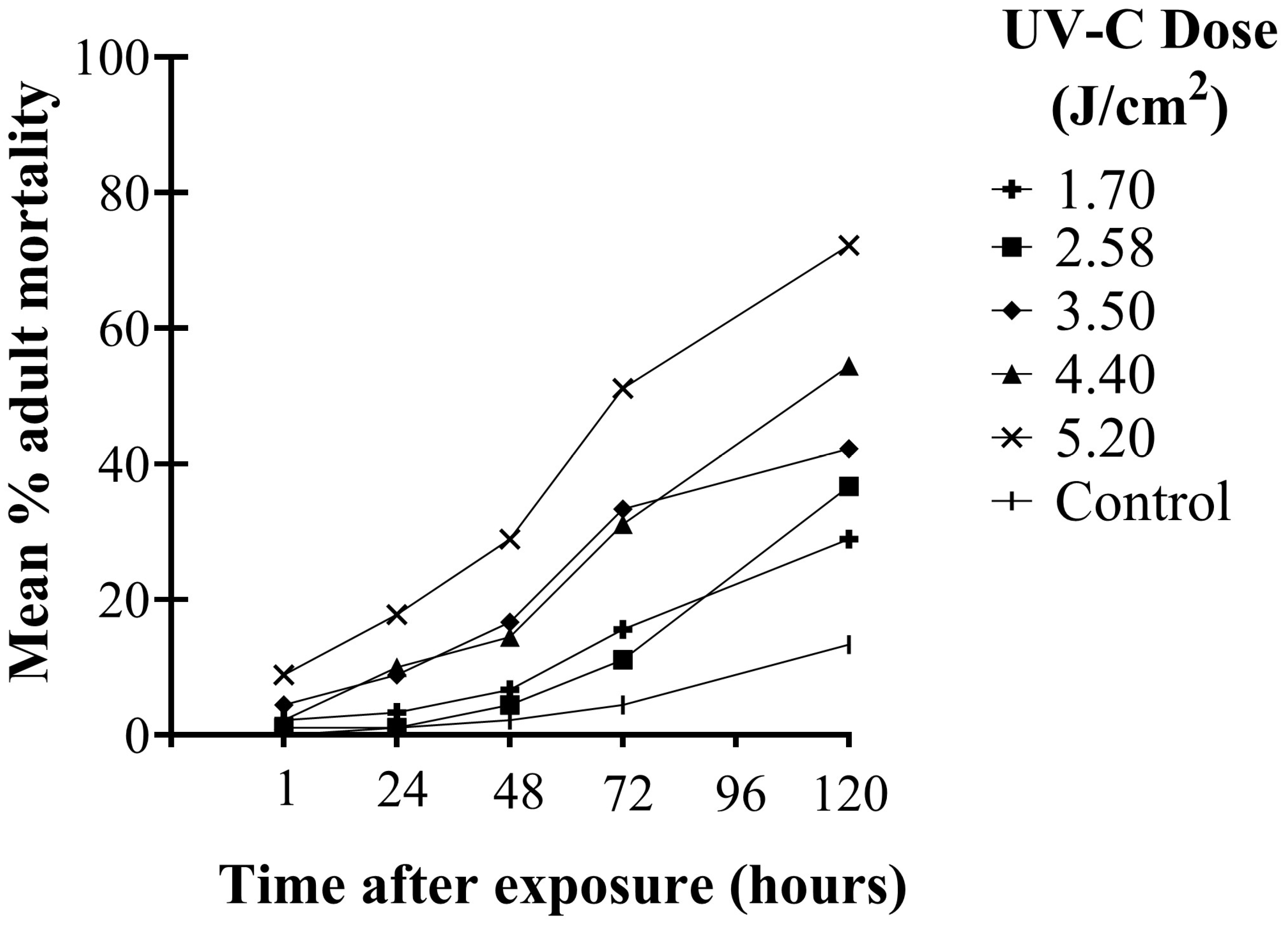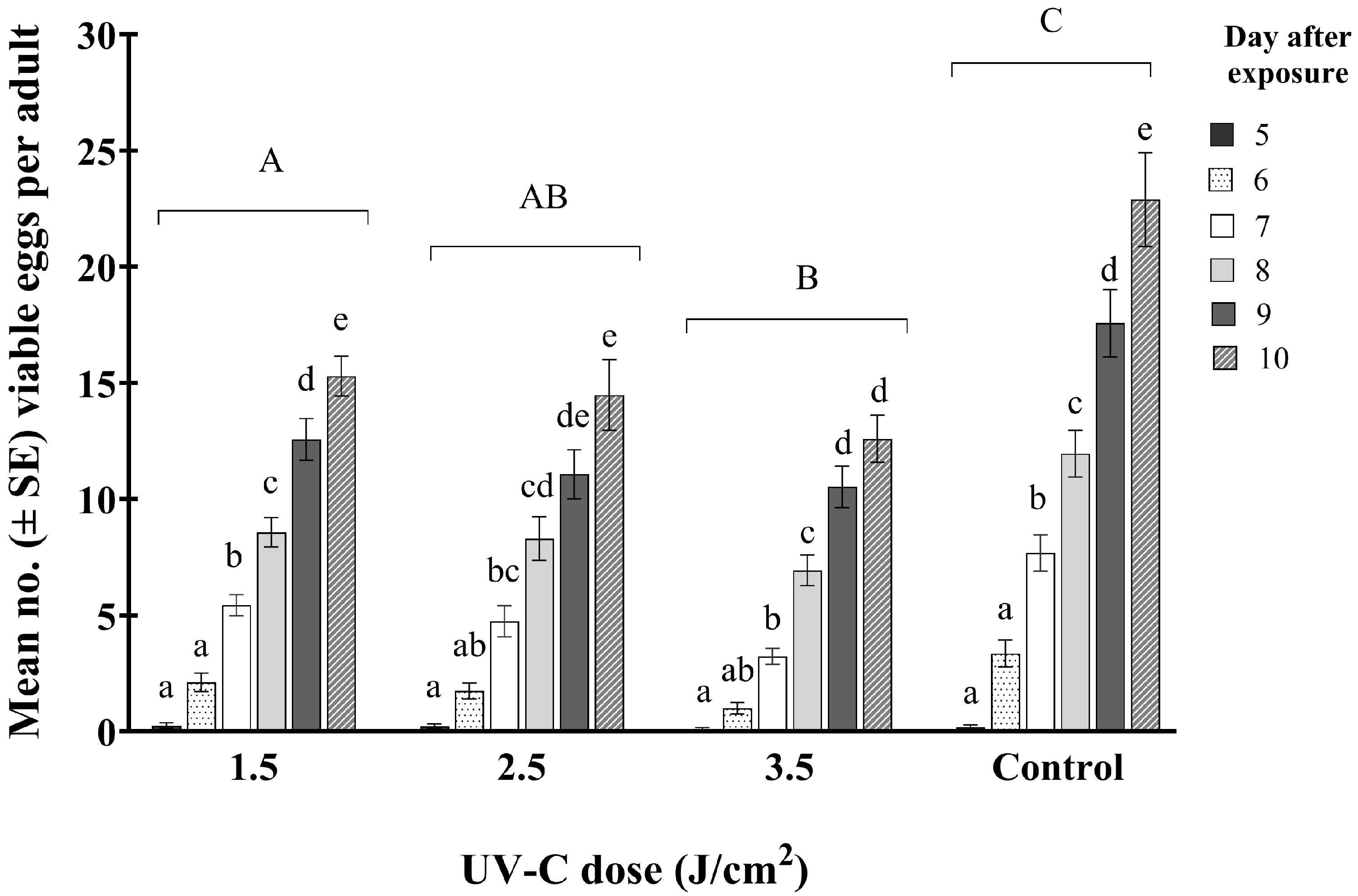Effects of Ultraviolet-C Exposure on Western Flower Thrips, Frankliniella occidentalis, and Ornamental Plants
Abstract
1. Introduction
2. Materials and Methods
2.1. UV-C Chamber
2.2. Effect of UV-C on WFT Adults and Second Instars

2.3. Effect of UV-C on WFT Fecundity and Egg Survival
2.3.1. Fecundity Trials
2.3.2. Egg Trials
2.4. Effect of UV-C Exposure on Plants
2.5. Statistical Analysis
3. Results
3.1. Effect of UV-C Exposure on WFT Mortality
3.1.1. Larvae
3.1.2. Adults
3.2. Effect of UV-C Exposure on WFT Fecundity and Egg Survival
3.3. Effect of UV-C Exposure on Plants
4. Discussion
5. Conclusions
Author Contributions
Funding
Institutional Review Board Statement
Informed Consent Statement
Data Availability Statement
Acknowledgments
Conflicts of Interest
References
- Reitz, S.R.; Gao, Y.; Kirk, W.D.J.; Hoddle, M.S.; Leiss, K.A.; Funderburk, J.E. Invasion biology, ecology, and management of western flower thrips. Annu. Rev. Entomol. 2020, 65, 17–37. [Google Scholar] [CrossRef] [PubMed]
- Pappu, H.R.; Jones, R.A.C.; Jain, R.K. Global status of tospovirus epidemics in diverse cropping systems: Successes achieved and challenges ahead. Virus Res. 2009, 141, 219–236. [Google Scholar] [CrossRef] [PubMed]
- Webster, C.G.; Reitz, S.R.; Perry, K.L.; Adkins, S. A Natural M RNA Reassortant arising from two species of plant- and insect-infecting bunyaviruses and comparison of its sequence and biological properties to parental species. Virology 2011, 413, 216–225. [Google Scholar] [CrossRef] [PubMed]
- Prins, M.; Goldbach, R. The emerging problem of tospovirus infection and nonconventional methods for control. Trends Microbiol. 1998, 6, 31–35. [Google Scholar] [CrossRef] [PubMed]
- Riley, D.G.; Joseph, S.V.; Srinivasa, R.; Diffie, S. Thrips vectors of tospoviruses. J. Integr. Pest Manag. 2011, 1, I1–I10. [Google Scholar] [CrossRef]
- Zhang, C.Y.; Meng, J.Y.; Wang, X.P.; Zhu, F.; Lei, C.L. Effects of UV-A exposures on longevity and reproduction in Helicoverpa armigera, and on the development of its F1 generation. Insect Sci. 2011, 18, 697–702. [Google Scholar] [CrossRef]
- Meng, J.Y.; Zhang, C.Y.; Lei, C.L. A Proteomic Analysis of Helicoverpa armigera Adults after exposure to UV light irradiation. J. Insect Physiol. 2010, 56, 405–411. [Google Scholar] [CrossRef]
- Llabrés, M.; Agustí, S.; Alonso-Laita, P.; Herndl, G.J. Synechococcus and Prochlorococcus cell death induced by UV radiation and the penetration of lethal UVR in the Mediterranean Sea. Mar. Ecol. Prog. Ser. 2010, 399, 27–37. [Google Scholar] [CrossRef]
- Zeeshan, M.; Prasad, S.M. Differential response of growth, photosynthesis, antioxidant enzymes and lipid peroxidation to UV-B radiation in three cyanobacteria. S. Afr. J. Bot. 2009, 75, 466–474. [Google Scholar] [CrossRef]
- Rastogi, R.P.; Kumar, A.; Tyagi, M.B.; Sinha, R.P. Molecular mechanisms of ultraviolet radiation-induced DNA damage and repair. J. Nucleic Acids 2010, 2010, 592980. [Google Scholar] [CrossRef]
- Sanha, R.P.; Hader, D.P. UV-induced DNA damage and repair: A review. Photochem. Photobiol. Sci. 2002, 1, 225–236. [Google Scholar] [CrossRef]
- Tachi, F.; Osakabe, M. Spectrum-specific UV egg damage and dispersal responses in the phytoseiid predatory mite Neoseiulus californicus (Acari: Phytoseiidae). Environ. Entomol. 2014, 43, 787–794. [Google Scholar] [CrossRef] [PubMed]
- Suthaparan, A.; Stensvand, A.; Torre, S.; Herrero, M.L.; Pettersen, R.I.; Gadoury, D.M.; Gislerod, H.R. Continuous lighting reduces conidial production and germinability in the rose powdery mildew Pathosystem. Plant Dis. 2010, 94, 339–344. [Google Scholar] [CrossRef] [PubMed]
- de Mello, P.P.; Onofre, R.B.; Rea, M.; Bierman, A.; Gadoury, D.M.; Ivors, K. Design, construction, and evaluation of equipment for nighttime applications of UV-C for management of strawberry powdery mildew in Florida and California. Plant Health Prog. 2022, 1, 321–327. [Google Scholar] [CrossRef]
- Needham, G.; Begg, C.; Buchanan, S. Ultraviolet C exposure is fatal to American house dust mite eggs. J. Allergy Clin. Immunol. 2006, 117, 28. [Google Scholar] [CrossRef]
- Collins, D.A.; Kitchingman, L. The effect of ultraviolet C radiation on stored-product pests. In Proceedings of the 10th International Working Conference on Stored Product Protection, Estoril, Portugal, 27 June–2 July 2010; Julius-Kuhn-Archiv. Volume 425, pp. 632–636. [Google Scholar]
- Faruki, S.; Dass, D.; Khan, A.R.; Khatun, M. Effects of ultraviolet (254 nm) irradiation on egg hatching and adult emergence of the flour beetles, Tribolium castaneum, T. confusum and the almond moth, Cadra cautella. J. Insect Sci. 2007, 7, 36. [Google Scholar] [CrossRef]
- Montemayor, J.D.; Smith, H.A.; Peres, N.A.; Lahiri, S. Potential of UV-C for management of two-spotted spider mites and thrips in Florida strawberry. Pest Manag. Sci. 2023, 79, 891–898. [Google Scholar] [CrossRef] [PubMed]
- Osakabe, M. Biological impact of ultraviolet-B radiation on spider mites and its application in integrated pest management. Appl. Entomol. Zool. 2021, 56, 139–155. [Google Scholar] [CrossRef]
- Murata, Y.; Osakabe, M. Photo-enzymatic repair of UVB-induced DNA damage in the two-spotted spider mite Tetranychus urticae. Exp. Appl. Acarol. 2017, 71, 15–34. [Google Scholar] [CrossRef]
- Suzuki, T.; Watanabe, M.; Takeda, M. UV tolerance in the two-spotted spider mite, Tetranychus urticae. J. Insect Physiol. 2009, 55, 649–654. [Google Scholar] [CrossRef]
- Leskey, T.C.; Short, B.D.; Emery, M.; Evans, B.; Janisiewicz, W.; Takeda, F. Effect of UV-C irradiation on greenhouse whitefly, Trialeurodes vaporariorum (Hemiptera: Aleyrodidae). Fla. Entomol. 2021, 104, 148–150. [Google Scholar] [CrossRef]
- Robson, T.; Klem, K.; Urban, O.; Jansen, M.A. Re-interpreting plant morphological responses to UV-B radiation. Plant Cell Environ. 2015, 38, 856–866. [Google Scholar] [CrossRef] [PubMed]
- Lindroth, R.L.; Hofman, R.W.; Campbell, B.D.; McNabb, W.C.; Hunt, D.Y. Population differences in Trifolium repens L. response to ultraviolet-B radiation: Foliar chemistry and consequences for two lepidopteran herbivores. Oecologia 2000, 122, 20–28. [Google Scholar] [CrossRef] [PubMed]
- Qi, J.; Zhang, M.; Lu, C.; Hettenhausen, C.; Tan, Q.; Cao, G.; Zhu, X.; Wu, G.; Wu, J. Ultraviolet-B enhances the resistance of multiple plant species to lepidopteran insect herbivory through the jasmonic acid pathway. Sci. Rep. 2018, 8, 277. [Google Scholar] [CrossRef] [PubMed]
- Demkura, P.V.; Abdala, G.; Baldwin, I.T.; Ballare, C.L. Jasmonate Dependent and independent pathways mediate specific effects of solar ultraviolet B radiation on leaf phenolics and antiherbivore defense. Plant Physiol. 2010, 152, 1084–1095. [Google Scholar] [CrossRef] [PubMed]
- Mazza, C.A.; Zavala, J.; Scopel, A.L.; Ballare, C.L. Perception of solar UVB radiation by phytophagous insects: Behavioral responses and ecosystem implications. Proc. Natl. Acad. Sci. USA 1999, 96, 980–985. [Google Scholar] [CrossRef] [PubMed]
- Izaguirre, M.M.; Mazza, C.A.; Svatos, A.; Baldwin, I.T.; Ballaré, C.L. Solar ultraviolet-B radiation and insect herbivory trigger partially overlapping phenolic responses in Nicotiana attenuata and Nicotiana longiflora. Ann. Bot. 2007, 99, 103–109. [Google Scholar] [CrossRef] [PubMed]
- Li, C.; Williams, M.M.; Loh, Y.T.; Lee, G.I.; Howe, G.A. Resistance of cultivated tomato to cell content-feeding herbivores is regulated by the octadecanoid-signaling pathway. Plant Physiol. 2002, 130, 494–503. [Google Scholar] [CrossRef] [PubMed]
- Ament, K.; Kant, M.R.; Sabelis, M.W.; Haring, M.A.; Schuurink, R.C. Jasmonic acid is a key regulator of spider mite-induced volatile terpenoid and methyl salicylate emission in tomatoes. Plant Physiol. 2004, 135, 2025–2037. [Google Scholar] [CrossRef]
- Sullivan, C.F.; Davari, A.; Kim, J.S.; Parker, B.L.; Skinner, M. Evaluation of a guardian plant system to suppress Frankliniella occidentalis (Thysanoptera: Thripidae) in greenhouse ornamentals. Pest Manag. Sci. 2023, 79, 3559–3569. [Google Scholar] [CrossRef]
- Yang, C.; Meng, J.; Yao, M.S.; Zhang, C.Y. Transcriptome analysis of Myzus persicae to UV-B stress. J. Insect Sci. 2021, 21, 7. [Google Scholar] [CrossRef] [PubMed]
- Nguyen, T.T.; Michaud, D.; Cloutier, C. A Proteomic analysis of the aphid Macrosiphum euphorbiae under heat and radiation stress. Insect Biochem. Mol. Biol. 2009, 39, 20–30. [Google Scholar] [CrossRef] [PubMed]
- Zhou, L.J.; Zhu, Z.H.; Liu, Z.X.; Ma, W.H.; Desneux, N.; Lei, C.L. Identification and transcriptional profiling of differentially expressed genes associated with response to UVA radiation in Drosophila melanogaster (Diptera: Drosophilidae). Environ. Entomol. 2013, 42, 1110–1117. [Google Scholar] [CrossRef] [PubMed]
- Poushand, F.; Aramideh, S.; Forouzan, M. Effect of ultraviolet (UV-C) in different times and heights on adult stage of whitefly (Trialeurodes vaporariorum). J. Entomol. Zool. Stud. 2017, 5, 864–868. [Google Scholar]
- Tuncbilek, A.S.; Ercan, S.F.; Canpolat, U. Effect of Ionizing (gamma) and non-ionizing (UV) radiation on the development of Trichogramma euproctidis (Hymenoptera: Trichogrammatidae). Arch. Biol. Sci. 2012, 64, 287–295. [Google Scholar] [CrossRef]
- Cui, H.; Zeng, Y.; Reddy, G.V.; Gao, F.; Li, Z.; Zhao, Z. UV Radiation increases mortality and decreases the antioxidant activity in a Tephritid Fly. Food Energy Secur. 2021, 10, e297. [Google Scholar] [CrossRef]
- Bridgen, M.P. Utilization of Ultraviolet-C (UV-C) Irradiation on Ornamental Plants for Growth Regulation. American Floral Endowment Special Research Report 2016, #534. Available online: https://endowment.org/wp-content/uploads/2013/03/534_BridgenReport-copy.pdf (accessed on 13 January 2024).
- Rousseaux, M.C.; Julkunen-Tiitto, R.; Searles, P.S.; Scopel, A.L.; Aphalo, P.J.; Ballare, C.L. Solar UV-B radiation affects leaf quality and insect herbivory in the southern beech tree Nothofagus antarctica. Oecologia 2004, 138, 505–512. [Google Scholar]
- Dinh, S.T.; Galis, I.; Baldwin, I.T. UVB Radiation and 17-hydroxygeranyllinalool diterpene glycosides provide durable resistance against mirid (Tupiocoris notatus) attack in field-grown Nicotiana attenuata plants. Plant Cell Environ. 2013, 36, 590–606. [Google Scholar] [CrossRef]
- Dillon, F.M.; Chludil, H.D.; Reichelt, M.; Mithöfer, A.; Zavala, J.A. Field-grown soybean induces jasmonates and defensive compounds in response to thrips feeding and solar UV-B radiation. Environ. Exp. Bot. 2018, 156, 1–7. [Google Scholar] [CrossRef]
- Escobar-Bravo, R.; Nederpel, C.; Naranjo, S.; Kim, H.K.; Rodriguez-Lopez, M.J.; Chen, G.; Glauser, G.; Leiss, K.A.; Klinkhamer, P.G.L. Ultraviolet radiation modulates both constitutive and inducible plant defenses against thrips but is dose and plant genotype dependent. J. Pest Sci. 2019, 94, 69–81. [Google Scholar] [CrossRef]





| Plant Type | Dose (J/cm2) | Days after Treatment | |||||||||
|---|---|---|---|---|---|---|---|---|---|---|---|
| 1 | 2 | 3 | 4 | 5 | 6 | 7 | 8 | 9 | 10 | ||
| African | Control | 0 | 0 | 0 a | 0 a | 0 a | 0 a | 0 a | 0 a | 0 a | 0 a |
| marigold | 0.5 | 0 | 0 | 0 a | 0 a | 0 a | 0 a | 0 a | 0 a | 0 a | 0 a |
| 1.5 | 0 | 0 | 0.6 ± 0.2 a | 0.6 ± 0.2 a | 0.6 ± 0.2 a | 0.6 ± 0.2 a | 0.6 ± 0.3 a | 0.3 ± 0.2 a | 0.2 ±0.2 a | 0.2 ± 0.2 a | |
| 2.5 | 0 | 0 | 1.9 ± 0.5 b | 1.9 ± 0.5 b | 2.1 ± 0.5 b | 2.1 ± 0.5 b | 2.1 ± 0.5 b | 1.9 ± 0.4 b | 1.8 ± 0.4 b | 1.8 ± 0.4 b | |
| 3.5 | 0 | 0 | 3.1 ± 0.5 c | 3.1 ± 0.5 c | 3.2 ± 0.5 c | 3.2 ± 0.5 c | 3.2 ± 0.5 c | 2.6 ± 0.5 b | 2.4 ± 0.5 b | 2.4 ± 0.5 b | |
| F4,30 | - | - | 43.97 | 43.97 | 41.57 | 41.59 | 41.58 | 40.82 | 37.86 | 37.86 | |
| p | - | - | <0.001 | <0.001 | <0.001 | <0.001 | <0.001 | <0.001 | <0.001 | <0.001 | |
| Calibrachoa | Control | 0 | 0 | 0 a | 0 a | 0 a | 0 a | 0 a | 0 a | 0 a | 0 a |
| 0.5 | 0 | 0 | 0.3 ± 0.3 a | 0 a | 0 a | 0 a | 0 a | 0 a | 0 a | 0 a | |
| 1.5 | 0 | 0 | 1.4 ± 0.5 b | 1.4 ± 0.5 b | 1.4 ± 0.5 b | 1.4 ± 0.5 b | 1.4 ± 0.5 b | 0.4 ± 0.3 a | 1.3 ± 0.4 b | 1.3 ± 0.4 b | |
| 2.5 | 0 | 0 | 3.4 ± 0.2 c | 3.4 ± 0.2 c | 3.6 ± 0.2 c | 3.6 ± 0.2 c | 3.4 ± 0.2 c | 1.9 ± 0.3 b | 2.7 ± 0.5 c | 2.7 ± 0.5 c | |
| 3.5 | 0 | 0 | 4.1 ± 0.2 c | 4.1 ± 0.2 d | 4.3 ± 0.2 d | 4.3 ± 0.2 d | 4.3 ± 0.2 d | 3.3 ± 0.4 c | 2.1 ± 0.6 c | 2.1 ± 0.6 c | |
| F4,30 | - | - | 72.16 | 148.35 | 203.56 | 203.56 | 176.83 | 122.29 | 41.75 | 41.75 | |
| p | - | - | <0.001 | <0.001 | <0.001 | <0.001 | <0.001 | <0.001 | <0.001 | <0.001 | |
| Portulaca | Control | 0 a | 0 a | 0 a | 0 a | 0 a | 0 a | 0 a | 0 a | 0 a | 0 a |
| 0.5 | 1.7 ± 0.3 b | 1.7 ± 0.3 b | 1.7 ± 0.3 b | 1.7 ± 0.3 b | 3.2 ± 0.2 b | 3.2 ± 0.2 b | 3.2 ± 0.2 b | 2.9 ± 0.1 b | 2.9 ± 0.1 b | 2.0 ± 0.1 b | |
| 1.5 | 4.4 ± 0.2 c | 4.4 ± 0.2 c | 4.8 ± 0.1 c | 4.8 ± 0.1 c | 4.8 ± 0.1 c | 4.8 ± 0.1 c | 4.8 ± 0.1 c | 4.0±0.3 c | 4.0 ± 0.3 c | 4.0 ± 0.3 c | |
| 2.5 | 5.0 ± 0.0 d | 5.0 ± 0.0 d | 4.4 ± 0.6 c | 5.0 ± 0.0 d | 5.0 ± 0.0 c | 4.8 ± 0.2 c | 5.0 ± 0.0 c | 4.8 ± 0.1 d | 5.0 ± 0.0 d | 5.0 ± 0.0 d | |
| 3.5 | 5.0 ± 0.0 d | 5.0 ± 0.0 d | 5.0 ± 0.0 c | 5.0 ± 0.0 d | 5.0 ± 0.0 c | 5.0 ± 0.0 c | 5.0 ± 0.0 c | 5.0 ± 0.0 d | 5.0 ± 0.0 d | 5.0 ± 0.0 d | |
| F4,30 | 2087.50 | 2087.50 | 77.37 | 2179.00 | 932.00 | 300.83 | 932.00 | 841.25 | 1751.50 | 1751.50 | |
| p | <0.001 | <0.001 | <0.001 | <0.001 | <0.001 | <0.001 | <0.001 | <0.001 | <0.001 | <0.001 | |
| Plant Type | Dose (J/cm2) | Days after Treatment | ||||
|---|---|---|---|---|---|---|
| 1 | 3 | 7 | 14 | 30 | ||
| African | Control | 0 | 0 | 0 | 0 | 0 |
| marigold | 0.5 | 0 | 0 | 0 | 0 | 0 |
| 1.5 | 0 | 0 | 0 | 0 | 0 | |
| 2.5 | 0 | 0 | 0 | 0 | 0 | |
| 3.5 | 0 | 0 | 0 | 0 | 0 | |
| F4,30 | - | - | - | - | - | |
| p | - | - | - | - | - | |
| Calibrachoa | Control | 0 | 0 a | 0 a | 0 a | 0 |
| 0.5 | 0 | 0 a | 0 a | 0 a | 0 | |
| 1.5 | 0 | 0 a | 0.8 + 0.2 b | 0.4 + 0.2 a | 0 | |
| 2.5 | 0 | 0.8 + 0.2 b | 3.6 + 0.2 c | 2.0 + 0.2 b | 0 | |
| 3.5 | 0 | 3.3 + 1.7 c | 3.0 + 0.2 c | 1.9 + 0.2 b | 0 | |
| F4,30 | - | 168.80 | 129.28 | 31.23 | - | |
| p | - | <0.001 | <0.001 | <0.001 | - | |
| Portulaca | Control | 0 | 0 a | 0 a | 0 a | 0 a |
| 0.5 | 0 | 0 a | 0 a | 0 a | 0 a | |
| 1.5 | 0 | 0 a | 0 a | 0 a | 0 a | |
| 2.5 | 0 | 0.9 + 0.2 b | 1.8 + 0.2 b | 0.4 + 0.2 a | 0 a | |
| 3.5 | 0 | 3.4 + 0.2 c | 2.8 + 0.3 c | 1.9 + 0.3 b | 0.7 + 0.2 b | |
| F4,30 | - | 100.11 | 48.64 | 30.11 | 18.00 | |
| p | - | <0.001 | <0.001 | <0.001 | <0.001 | |
Disclaimer/Publisher’s Note: The statements, opinions and data contained in all publications are solely those of the individual author(s) and contributor(s) and not of MDPI and/or the editor(s). MDPI and/or the editor(s) disclaim responsibility for any injury to people or property resulting from any ideas, methods, instructions or products referred to in the content. |
© 2024 by the authors. Licensee MDPI, Basel, Switzerland. This article is an open access article distributed under the terms and conditions of the Creative Commons Attribution (CC BY) license (https://creativecommons.org/licenses/by/4.0/).
Share and Cite
Davari, A.; Sullivan, C.F.; Rea, M.S.; Skinner, M.; Parker, B.L. Effects of Ultraviolet-C Exposure on Western Flower Thrips, Frankliniella occidentalis, and Ornamental Plants. Int. J. Plant Biol. 2024, 15, 468-481. https://doi.org/10.3390/ijpb15020036
Davari A, Sullivan CF, Rea MS, Skinner M, Parker BL. Effects of Ultraviolet-C Exposure on Western Flower Thrips, Frankliniella occidentalis, and Ornamental Plants. International Journal of Plant Biology. 2024; 15(2):468-481. https://doi.org/10.3390/ijpb15020036
Chicago/Turabian StyleDavari, Agrin, Cheryl F. Sullivan, Mark S. Rea, Margaret Skinner, and Bruce L. Parker. 2024. "Effects of Ultraviolet-C Exposure on Western Flower Thrips, Frankliniella occidentalis, and Ornamental Plants" International Journal of Plant Biology 15, no. 2: 468-481. https://doi.org/10.3390/ijpb15020036
APA StyleDavari, A., Sullivan, C. F., Rea, M. S., Skinner, M., & Parker, B. L. (2024). Effects of Ultraviolet-C Exposure on Western Flower Thrips, Frankliniella occidentalis, and Ornamental Plants. International Journal of Plant Biology, 15(2), 468-481. https://doi.org/10.3390/ijpb15020036





